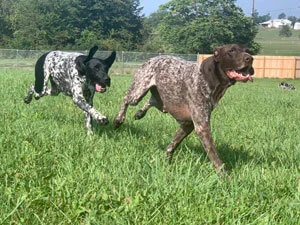It’s HOT in PA: Here are 5 Tips to Keep Pets Safe in the Heat
Fall is nearly here, but it’s hotter than ever in some parts of the country. While most of Pennsylvania is spared from unspeakable heat waves plaguing places like California, regions of the state have still reached triple digits in the past 30 days.
This level of heat isn’t just tough on us; it’s also tough on our pets! And unlike us, pets don’t have the awareness to know when they’re getting too hot to be healthy. They definitely can’t communicate that they want the thermostat to be turned down!
To protect your pet from the heat, keep a close eye on them at all times during the day, and follow these five tips for pet summer heat safety.
Know the Signs of Heat Stress
Your first priority in any high-heat situation is to watch pets closely for signs of heat stress. Often, once a pet has heat exhaustion, they are already at risk of a serious medical event. Active monitoring is crucial for when your pet needs a cool down, stat.
Symptoms of heat stress include:
- Panting and heavy breathing
- Excessive drooling or foaming
- Rapid heart rate
- Sluggish responses
- Lethargy
- Body or ears feel excessively hot to the touch
- Red gums
- Muscle tremors or seizures
- Vomiting
Never Ever Leave a Pet Unattended in a Car for More Than Five Minutes
It doesn’t have to be a heatwave for conditions in your car to be fatal. The American Kennel Club notes that in 70° F weather, it only takes 20 minutes for the temperature in a parked car to reach 100° or higher. Cracking the windows doesn’t help, either.
Because of the risk of overheating, never leave a pet unattended in a parked vehicle for more than five minutes or fewer, as a rule. Pennsylvania recently passed a law allowing local law enforcement to be exempt from damages to your vehicle if they feel it is necessary to break a window or perform a similar maneuver to rescue a pet from possible overheating.
If you can, instead of taking your pets on errands leave them at home or drop them off at doggie daycare, where the air conditioning can keep them cool.
Refresh Water Often, Especially Outside
Dehydration is a major pet risk during hot weather. The signs of dehydration can often be subtle, and regular dehydration can lead to cumulative damage to your pet’s vital organs.
To keep your pet hydrated, offer clean water in several stations throughout their environment. Ensure that dogs are encouraged to drink after — and, if possible, during — any periods of exercise.
Cats that go outdoors need a source of fresh, clean water that is replenished at least once a day. Also, monitor your cat to ensure that they’re drinking regularly since even indoor cats can be more prone to dehydration during the hotter months.
When providing water outside, opt for narrow but deep vessels placed in the shade, says Alley Cat Allies. This slows evaporation and can deter the growth of algae.
Be Careful About Outdoor Exercise
Keeping your pets active is a must, but be smart about it during the warmer months.
- Limit activities to short sessions with the opportunity to cool and rest in between.
- Avoid pushing your pet too hard, especially during the hottest parts of the day.
- Monitor for the signs of heat stress listed above.
- Carry along some water for longer walks or extended outings.
Indoor/outdoor cats should be given breaks inside throughout the day, especially during the hottest periods. Make sure they periodically come inside to cool down and drink some water (even if they want to protest about it).
Another major thing to watch out for in hot months are hot surfaces that can hurt your pup’s paws. Try to avoid asphalt, and limit walks to earlier or later in the day when temperatures have gone down. If your dog has sensitive paws — or they’re used to several walks a day — consider purchasing safety socks or booties that can protect their pads.
Outdoor cats can get hot paws, too! Try to avoid having surfaces that heat up quickly where they can walk or lay upon them, such as covering up metal objects out in the yard or using the hose to spray down patios that bear the brunt of the full sun.
Speaking of paw pads, monitor your pet’s paws during the summer, and moisturize them as needed to prevent cracking and injury.

